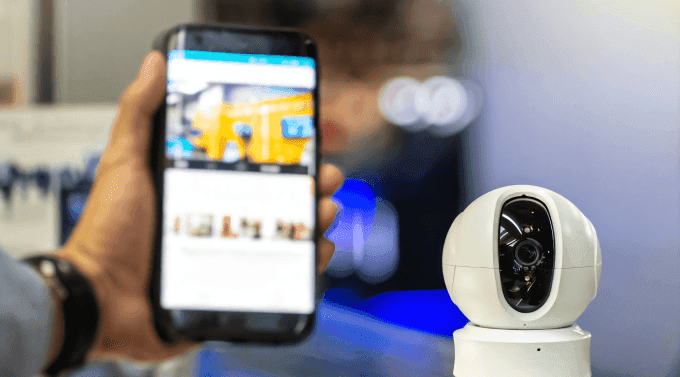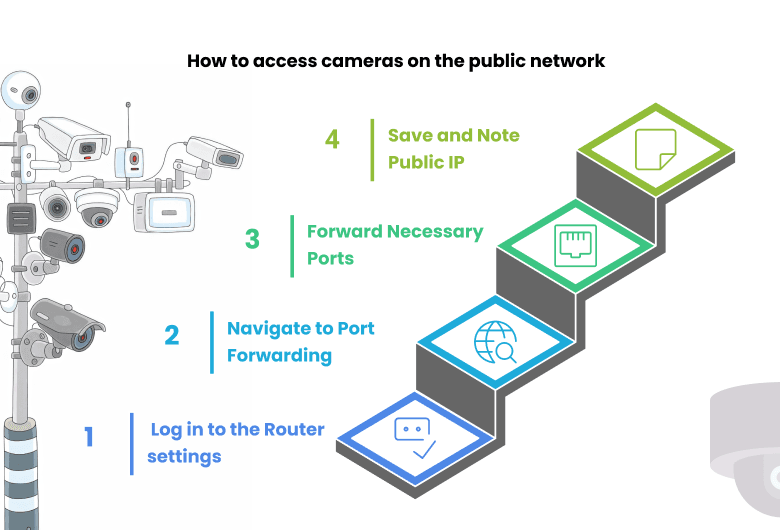How to enable surveillance camera for public access

A remote viewing camera is a CCTV surveillance device that enables users to monitor and access live video feeds from a distance. Remote viewing CCTV can be easily accessed and controlled anywhere with an Internet connection. In this blog post, we are going to provide a stepwise guide for enabling and configuring a CCTV camera for public access integrating with AI video analytics software using RTSP (Real-time Streaming Protocol). The step helps in ensuring reliable and secure access to live camera streams over a public network.
One can realize CCTV remote viewing from anywhere in the world in two ways by connecting IP cameras over the internet through an app/client and setting up port forwarding. This blog post will show what to do when users cannot view security cameras remotely.
What are the steps to enable public access?
Enabling RTSP on the CCTV Camera
After logging in to camera settings, open your web browser and enter the local IP address of your CCTV camera. Users should use their login using valid credentials. (default username: admin).
Following this navigate to the RTSP settings. With stepwise direction, it goes like configuration→Network→Advanced Settings→RTSP. At this stage, it is important to ensure that the RTSP is enabled along with the RTSP port. Save the settings by clicking Save & apply to confirm the stages.
Identifying the RTSP URL Hikvision cameras follow a standard RTSP URL format subtype> Examples: ●Main Stream: rtsp://admin:password@123.456.78.9:554/Streaming/Channels/101 ●Sub Stream: rtsp://admin:password@123.456.78.9:554/Streaming/Channels/102
What are the URL components required?
Username: It comprises the camera’s username
Password: It comprises the camera’s password
Public IP address: The public IP address or DDNS domain name of the camera
Port: The RTSP port.
Channel ID: enter the channel ID.
How to access cameras on the public network

Using the port forwarding technique
The user network should have a static IP and if the network does not have a network service to obtain, then the internet service provider needs to be connected.
Step: 1. Log in to the Router settings → Open your router’s admin page using its IP address → Log in using your router’s credentials
Step: 2. Navigate to Port Forwarding → Locating the port forwarding section.
Step: 3. Forward Necessary Ports Forward Necessary Ports: Forward the following ports to the local IP address of your CCTV camera: HTTP Port (default: 80): For web interface access. RTSP Port (default: 554): For RTSP stream access
Step: 4. Save and Note Public IP → Save the port-forwarding configuration. Note the public IP address assigned by your router.
Using DDNS (Dynamic Domain Name System)
Enable DDNS on the camera → Log in to the camera’s web interface. Follow the steps like go to Configuration → Network → Advanced Settings → DDNS.
Configuring the DDNS
Allowing DDNS & choosing a provider like
- HiDDNS (Hikvision’s service).
- No-IP (requires account creation).
- DynDNS.
Harnessing the DDNS domain name
Replace the public IP in the RTSP URL with the DDNS domain. Testing the RTSP stream Utilizing FFmpeg Install FFmpeg and run the command in the terminal or command prompt ffmpeg-i\"rtsp://admin:password@123.456.78.9:554/Streaming/Channels/101" -c copy output.mp4. This will save the stream to output.mp4.
Using the VLC media player
Firstly open the VLC media player, navigate to the Media and then go to Open network stream. Afterwards, enter the RTSP URL & click on ‘Play’ to view the stream. In this context, it is important to follow some of the troubleshooting tips for ensuring the smooth functioning of the AI video surveillance system.
RTSP is unable to work properly
First, it is necessary to ensure that the RTSP is enabled in the camera settings. Verify the IP address, port, and credentials. Confirm the camera and viewing device are on the same network. Unable to access the public network? Then it is time to double check port forwarding or DDNS configuration. Subsequently, then verify that the ISP does not block required ports. Stream buffering problems Utilize the stream buffering for lower bandwidth consumption.
What can you do if you are unable to watch CCTV cameras using the network through port forwarding?
At the very outset, ensure that your cameras are connected to the network. Check if all the ports of the network configuration are mapped to the internet. Open the firewall in the router to enable internet access to the camera. If your computer has a firewall, ad-blocking software, or anti-virus software you can try to temporarily disable them and connect the server again. It is important to check your web server settings and ensure that your user account has permission to access the IP cameras. Ensure that the cameras are compatible with the web browser you are using for remote viewing.
Is it possible to set up my IP cameras for remote viewing without using a DDNS service?
When the Internet service provider provides a static IP address, users can remotely view security cameras using the Internet with the same IP address. In this scenario, the DDNS setup is not required at all. There is another significant way to stream CCTV cameras over the Internet online and it can be done outside of network settings.
Final thoughts
As one of the leading AI video analytics companies, Visionfacts AI sheds a major focus on the operations of surveillance cameras for public access. Using this guide and following the steps, users can successfully enable RTSP on their CCTV camera, configure public access via port forwarding or DDNS and evaluate the stream using RTSP-compatible players like VLC or FFmpeg. Do you want to know more about AI-based video analytics software for your surveillance cameras? Get in touch with our experts.